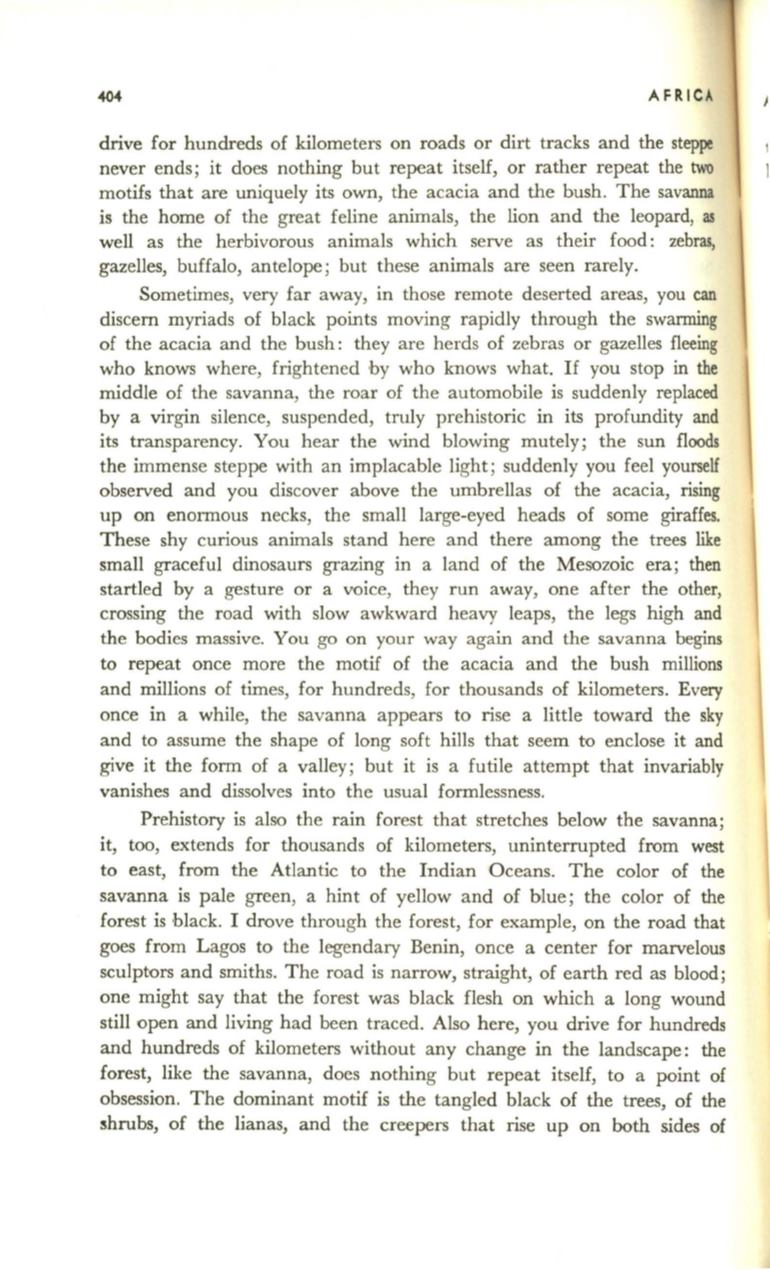
A F
RICA
drive for hundreds of kilometers on roads or dirt tracks and the steppe
never ends; it does nothing but repeat itself, or rather repeat the
two
motifs that are uniquely its own, the acacia and the bush. The savanna
is the home of the great feline animals, the lion and the leopard, as
well as the herbivorous animals which serve as their food: zebras,
gazelles, buffalo, antelope; but these animals are seen rarely.
Sometimes, very far away, in those remote deserted areas, you can
discern myriads of black points moving rapidly through the swanning
of the acacia and the bush: they are herds of zebras or gazelles fleeing
who knows where, frightened by who knows what.
If
you stop
in
the
middle of the savanna, the roar of the automobile is suddenly replaced
by a virgin silence, suspended, truly prehistoric in its profundity and
its transparency. You hear the wind blowing mutely; the sun floods
the immense steppe with an implacable light; suddenly you feel yourself
observed and you discover above the umbrellas of the acacia, rising
up on enormous necks, the small large-eyed heads of some giraffes.
These shy curious animals stand here and there among the trees like
small graceful dinosaurs grazing in a land of the Mesozoic era; then
startled by a gesture or a voice, they run away, one after the other,
crossing the road with slow awkward heavy leaps, the legs high and
the bodies massive. You go on your way again and the savanna begins
to repeat once more the motif of the acacia and the bush millions
and millions of times, for hundreds, for thousands of kilometers. Every
once in a while, the savanna appears to rise a little toward the sky
and to assume the shape of long soft hills that seem
to
enclose it and
give it the form of a valley; but it is a futile attempt that invariably
vanishes and dissolves into the usual formlessness.
Prehistory is also the rain forest that stretches below the savanna;
it, too, extends for thousands of kilometers, uninterrupted from west
to east, from the Atlantic to the Indian Oceans. The color of the
savanna is pale green, a hint of yellow and of blue; the color of the
forest is black. I drove through the forest, for example, on the road that
goes from Lagos to the legendary Benin, once a center for marvelous
sculptors and smiths. The road is narrow, straight, of earth red as blood;
one might say that the forest was black flesh on which a long wound
still open and living had been traced. Also here, you drive for hundreds
and hundreds of kilometers without any change in the landscape: the
forest, like the savanna, does nothing but repeat itself, to a point of
obsession. The dominant motif is the tangled black of the trees, of the
shrubs, of the lianas, and the creepers that rise up on both sides of


